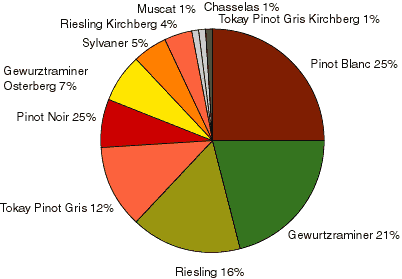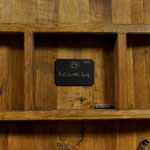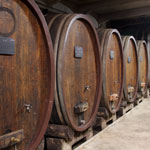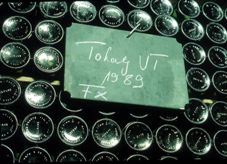Vineyard, wine making
The winefield of Alsace, between mountain and plain
The winefield of Alsace is located in the area where the ancient mountains of the Vosges-Forêt Noire descend and fall away. This tectonic event, which created the plain of Alsace some 50 million years ago, passed through two stages: a first slow phase, and a second more violent and rapid one.
The result was two lines of fractures running North to South. These are the fault-line of the Vosges region, running along the foothills of the mountains, and the fault-line of the Rhine between the plain and the hills. The two lines define three well-known geographical zones, namely the mountainous area of the Rhine.
The western boundary of the winefield itself is defined by the Vosges chain of mountains, and the eastern boundary is the plain of Alsace. Between the western edge (the Vosges) and the eastern edge (the plain of Alsace) one can distinguish four discrete areas:
- the ridge of the Vosges mountain chain, soaring to an altitud of around 450 m.
- the hills of the lower Vosges, composed of numerous different geological materials which create the region's "mosaic of soils".
- the plain of the Rhine, with its fertile alluvial cones formed as the rivers of the Vosges run off the hills,
- the embankments of loess, a clay-silt deposit, which have formed mainly where the plain meets the hills.
The outstanding feature of the winefield is an extreme diversity of soils types within limited geographical zones.
It is offered protection from the effects of an oceanic climate by several geographical forces : the Vosges mountains, the semi-continental nature of the Alsace plain, and the foehn (a warm dry wind which rises from the Mediterranean and blows down the Northern slopes of the Alps). The result is one of the lowest rainfall averages in France. The summers are hot and stormy, with many hours of direct sunshine. Moreover, storms are often the only source of water at this time of year. The winters are usually cold, but it is a cold mitigated by the fact that the whole of the winefield faces a south-easterly direction.
A Ribeauvillé, une mosaïque de terroirs
The vineyards of Ribeauvillé are located in a large area of geological fractures. There is a main network of fault-lines running North-South, crossing smaller ones running East-West, and there have been periodic tectonic collapses, all of which have combined to create distinct geological strata.
These have brought about a structure comprising clearly split-up geological compartments (in other words a structure like a mosaique).The compartments consist of hard limestone, clay and marl from the Liassic and Triassic periods, sandstone clay, and chalky calcareous conglomerates from the Oligocene epoch. Very old cristalline soils are also present under the castles (Gneiss from Precambian era).
In the valley and across the plain there are also silt-laden deposits from the Triassic period, and sandy or stony glacis and alluvions.
The microclimate of Ribeauvillé is characterised by its low rainfall - between 550 mm and 650 mm per year. One small chalky hill in the north of the vineyard is even home to the green lizard, a Mediterranean species.
In the spring one also sees the blooms of species of orchid typical of dry calcareous hills. In summer the days are hot. At night, however, temperate catabatic winds emerge from the valley to cool the atmosphere. This temperature alternation favours the development of fine and delicate aromas, particularly in the Gewurztraminer species of grape.
In autumn, mists form on the plain above the Fecht and Ill rivers, which are conducive to what is known as the "noble rot", a process necessary for the late harvest wines ("Vendanges Tardives") and the superior grape selection wines ("Sélections de Grains Nobles").
The quality of Ribeauvillé's soils has been recognised by the INAO, the organisation which oversees all label-of-origin wines ("Appelation d'Origine Contrôlée" or "AOC"). In fact we are fortunate enough to have three wine-growing areas on the edges of Ribeauvillé community district which merit the class of "Grand Crus": Kirchberg, Geisberg and Osterberg.
Vines planted predominantly on the slopes
Some 85% of our vineyard, comprising a total 32 hectares and further 5 hectares of rented land, is situated on the edges of community district of Ribeauvillé.
The remainder is situated on the edges of nearby Bergheim and Hunawihr. All our vines are planted in high regions, and 80% of them are on the steep slopes between the "Route du Vin" and the hills of the Vosges.
This concentration of the vineyards on the best hillsides of Ribeauvillé is a real advantage in the production of our characteristic vintages from these exceptional soils.
70% "noble" vine varieties

Diagram of vine varieties
Nearly 70% of our vines in production are classified "noble" varieties :
- 28% Gewurztraminer
- 20% Riesling,
- 13% Pinot Gris
- 7% Pinot Noir
- 1% Muscat
The vines classified as "Grands Crus" represent 12% of our vineyard by area, or nearly 4 hectares of producing vines. However, 70 ares (7,000 square meters) of young Grand Crus vines are currently not in production.
It is worth noting that 50 ares of the Kirchberg Grand Cru area are planted with the Pinot Blanc variety of grapes, used for the production of special vintages ("Cuvées Spéciales"). As Pinot Blanc is not one of the grape varieties which may be used in the Grand Crus wines of Alsace, you will never see its name on the label of a Grand Cru wine.
The majority are mature vines - the situation as of 30.08.2002
The age of the vines is important when assessing the quality potential of a vineyard. It is generally accepted that vines less than 10 years old will yield lively and light wine, whilst the mineral qualities of and the depth are only achieved later, when the roots have penetrated further into the earth. The "Institut National des Appellations d'Origine" (INAO), the organisation which oversees all label-of-origin wines, classifies vines aged over 25 years as mature ("Vieilles Vignes").
Maintaining adult and even very old vines is a clear policy for us. It is in fact one of the means we use to regulate the production rate of our vine stock, so as to avoid over-production and a consequent dilution of the wine's quality. However maintaining mature vines means lots of work, because all the processes involved are difficult to mechanise, particularly those of supporting and pruning the vines. We always use the system of companion planting, replacing failing vine stems with new seedling. We replace entire vines only when the vine itself or the grafting stems are not suitable for the soil or in other prevailing conditions. In 1999 we replaced almost 2000 vine stems, mostly of the Riesling, Pinot Gris and Gewurztraminer varieties by companion planting.
Managing the vineyard to create expressive wines
Before planting a plot of land we let the soil rest for a few years, giving it chance to regenerate and purify itself. It is important to ensure that the roots of the previous vines are all dead, so that they cannot act as a medium for disease-carrying micro-organisms. As for the choice of grafting stock, we prefer low-yield varieties with roots which drive deep underground, wherever the soil conditions and vine variety concerned will allow it. Such graft stocks develop strong root systems in the porous layer below where hydrocarbons form, and are efficient in extracting its mineral content. This contributes to the "soil effect", i.e. making a wine which expresses its own particular soil type. We currently choose graft stocks 161-49, Gravesac or 3309 in preference to the more traditional variety S04, whose presence on our vineyard is being reduced regularly.
The density of planted vines is increased, while still allowing certain operations to be mechanised.
We are careful not to plant rows too close together. This allows the machines to pass through easily, aids the circulation of air, avoids the danger of those diseases which can develop when rows are too close to each other, and above all gives the vines a clear view of the sun.
The most recently planted vines of the Grands Crus Kirchberg and Osterberg are planted at a density of 6250 stocks per hectare.
For the remainder of the vineyard we have chosen a density of around 5600 stocks per hectare. We follow the principle that for a given quantity of produce it is better that the fruit comes from as many individual vine stocks as possible. The fewer grapes each vine stock produces, the greater the chances of obtaining concentration. The variable that we regulate is the distance between stocks in the same row. At present the width of the rows is fixed according to the soil conditions at between 1.50 m for Grand Crus varieties, and 1.60 m to 1.70 m for others.
In winter 1999 we returned to working the soil with the plough. This practice has been somewhat forgotten for several years, but recent studies have shown it to be important for the soil's microbial life, which is itself a major contributor to creating a wine which expresses the soil. We wanted to avoid using decompacting machines for this first process - consisting of ploughing to a depth of 15 to 20 cm - so as not to adversely affect the vines' root systems.
On all the plots of land where it was possible to plough, the work was carried out on just one row in two.
The other row was left grassy. We chose a system of natural vegetation management which consists of regulating the natural level of vegetation by scything, after a maximum number of flowers have blossomed. We preferred this form of plant cover to artificial plant cover because it allows a wide diversity of species to thrive on the land, and so avoids the situation of having just two monocultures - the vine and the plant - living side by side. It is important to conserve a certain biodiversity in the vegetation, which then makes an excellent biotope for numerous insects. Some of them, like the ladybird, prey on insects which destroy the vines.
The height of plant cover and the way it is nurtured do have an effect on the quality of the future harvest. The height should be adapted for every plot of gound, to suit the productive strength of the vines there, and the type of wine to be made. Plots of land which are set to produce late harvest wines ("Vendanges Tardives") and superior grape selection wines ("Sélections de Grains Nobles") are defined in the winter, and the vegetation is cut accordingly. The aim is to produce the very low yields per vine which are necessary for achieving wines of great maturity.
Our choice of phyto-sanitary treatments are veering more toward informed combattive techniques. We have been certified according the TYPLO specification for the 2003 to 2007 vintages. This specification is recognised by the Organisation Internationale de Lutte Biologique et Intégrée. As from 2005 we started in parallele a certification in organic farming.
In the spring/summer of 1999, for example, we kept a regular population count of the spieces of butterflies whose eggs become vine-eating caterpillars, and so were able to evaluate the level of risk they posed. Counting allowed us to avoid one treatment process altogether, and to target a second one solely at areas where it was needed. Accurate knowledge about the population size of vine-eating insects brings the added advantage of allowing the use of products which are more specific to the situation, and more neutral on the environment.
In 1999 all of our vines on the plots devoted to the Grands Crus Kirchberg and Osterberg were protected against grape worms for the very first time by a technique based on sexual confusion. This technique consists of filling the air with the odour molecules the butterflies use to locate each other prior to mating.
If the insects cannot meet, the females cannot lay fertilised eggs, and therefore cannot give birth to caterpillars which would eat into the fruit. No synthetic fertilizer has been used since 1995, so as to limit the productive strength of the vines, and to force them to seek their nutrients in the deeper soil. Only a small amount of plant compost was used in 1999 on certain plots of ground which lacked humus.
Traditional harvesting exclusively by hand
Before the harvest we take particular care to observe the process of the fruit ripening on the various plots which make up the vineyard. This allow us to harvest at the best possible maturity, according to the specific properties of each patch of land.
All our plots of vines are harvested by hand. In our view this is the only way which exists today to harvest grapes whole, without crushing or damaging them.
Moreover, when conditions are difficult it is possible to sort grapes on the plot, harvesting only fruit which is healthy and ripe.
When harvesting fruit for the late harvest wines ("Vendanges Tardives") and superior grape selection wines ("Sélection de Grains Nobles"), one must take only those grapes which have undergone the sugar concentration process known as "noble rot" ("Pourriture Noble"). Selecting them can only be done by hand.
Restraint, the key to success in the wine making process
Our whole philosophy regarding the production of wine can be summed up in a few simple words : hygiene, simplicity and gentleness.
A wine should be the product of a well-managed process of fermenting grape juice.
Slow gentle pressing
The first pneumatic press arrived at our wine plant for the harvest of 1982.
Today we use three high-volume pneumatic presses, which allow us to carry out long cycles of pressing.
For the less sophisticated grape varieties and rapid production wines, these presses are filled by a system of feeds and pumps.
The third press, installed for the 1999 harvest, is fitted with equipment which can load it very gently with unbroken fruit. The grapes are lifted to the roof of the plant in their containers, and poured into a duct inclined at an angle of 40° from vertical, coming out again at the rim of the press. The grapes thus slide into the machine without being damaged.
This system was chosen in preference to systems using conveyor belts, endless screws or other transmission equipment, which have the disadvantage of slightly pummeling the fruit, and can even be a source of contamination if ever they are cleaned incorrectly.
To the best of our knowledge it is not possible to carry out the operation more gently. Of course we also take extra care that our handling of the grapes before they reach the press does not bruise them. The containers, for exemple, are never packed down, and are only ever filled to two thirds of their capacity.
In 1999 half of the must we produced came from the loading and pressing of unbroken grapes.
The process of pressing is long and measured. We take the view that since it takes a year for a harvest to reach maturity, and several years for a wine to become ready to drink, it is worth sacrificing a few extra hours at the pressing stage to obtain clear juice.
The manufacturers of the presses recommend a pressing time of 2 hours. The shortest of our pressing cycles however, lasts for 4 hours, twice the recommended time. Furthermore it is not at all unusual for us to carry out cycles lasting five hours or more...anything up to 16 hours in fact.
Long pressing cycles are used for top quality, highly expressive wines such as the Grands Crus, the late harvest wines ("Vendanges Tardives"), or the special selection wines ("Sélections de Grains Nobles" or "Cuvées Spéciales).
We always start the process by draining the grapes, without adding any pressure. After that the pressing cycle is carried out over as long a time as possible, at very low pressure. With some vintages the process also involves soaking the fruit skins inside the press. Two of the three presses are fifted with locks designed for this purpose. The aim of this process is to extract as many of the aromatic compounds in the grape skin as possible.
The juice flows under the force of gravity into vats situated on two levels beneath the presses.
Similarly the removal of impurities is done by allowing the liquid to rest, and letting the force of gravity act. Only those particles of impurity suspended in the must are removed by centrifugal force, after which the clear juice is poured again into the same vat as before.
Drawing the fine particles out of the must during siphoning would risk introducing a herbaceous or vegetable flavour. Our method avoids this, and maximises the chances of producing wine with finesse, body and roundness.
Once cleared and strained of impurities, the must is transferred to the vat in which it will be left to ferment.
Traditional wine making processes
 Our aim is to allow as much of the must as possible to start fermenting on its own, with its own natural yeasts. We do not use any anti-botrytis on our vines, which significantly helps to establish a viable yeast life on the skins of the grapes. In cases where there are problems or specific risks, or when the fermenting process does not begin of its own accord, we carry out the yeasting using stocks of yeast species specific to the Alsace winefield.
Our aim is to allow as much of the must as possible to start fermenting on its own, with its own natural yeasts. We do not use any anti-botrytis on our vines, which significantly helps to establish a viable yeast life on the skins of the grapes. In cases where there are problems or specific risks, or when the fermenting process does not begin of its own accord, we carry out the yeasting using stocks of yeast species specific to the Alsace winefield.
The temperatures at fermentation are carefully managed so as to avoid extremes. We have a "natural" method of doing so, a method used since time immemorial, consisting of choosing the type of vat, its positioning and its surroundings in the cellars according to the grape variety and the type of wine desired.
Thus a wine which is likely to rise in temperature will be placed in a draughty part of the cellars where the heating will be tempered. The temperature of grape varieties with subtle, floral or fruity aromas (such as the Sylvaner, Pinot Blanc, Pinot, Auxerrois, Riesling or Muscat) is regulated by the circulation of cold water through trailling devices in the vats. The aim is simply to avoid over-high temperatures which can damage a wine by reducing its fruity or floral characteristics. The only additive which oenological science will not allow us to do without is SO2.
 The question of eliminating SO2 is a difficult one. We do, however, carefully calculate the amounts used, and make sure they are well under the maximum doses permitted. The fact that our wines are made of grapes which come from relatively deep and partially calcareous soils means that they need time to fully express themselves. The expression of a soil only comes about several years. In order to reach such a stage of development it is necessary to ensure that the wine will keep well.
The question of eliminating SO2 is a difficult one. We do, however, carefully calculate the amounts used, and make sure they are well under the maximum doses permitted. The fact that our wines are made of grapes which come from relatively deep and partially calcareous soils means that they need time to fully express themselves. The expression of a soil only comes about several years. In order to reach such a stage of development it is necessary to ensure that the wine will keep well.
Today the addition of sulphur dioxide is the only efficient way of conserving wines, and therefore of reaching an expression of their soil.
Our internal laboratory is able to carry out an accurate and advanced running analysis of the vats. This allows us to monitor the chemical balances achieved by the wines over the courses of the different stages of fermentation, and above all allows us to avoid them developing in a direction we do not wish for.
Hundred year-old oak casks are employed as tools for wine processing and creation. The casks, each with their own personality, are chosen according to the grape variety and the intended wine. Using them is never a question of wishing to add a woody flavour to the wines. Casks are merely vessels which are less water-tight and more air-permeable than vats. Casks also have properties of thermal conductivity which can be interesting for certain wine-making processes.
 There is a technique of clearing a wine of the cloudiness which can appear under certain conditions, based on the powerful absorbing properties of the clay bentonite. It is not used systematically in every case, but an analysis of each vat is carried out to determine if it is needed. If there is a need, we carry out the clearing process using limited doses of clay. We have, however, observed that a very large number of wines never need clearing by adsorption, and the stability of the wine is never adversely affected by missing it. Each year we carry out tests to improve our knowledge of this subject. The aim is only to carry out clearing by adsorption on wines which really need it, and even then to do it with a minimal dose of clay, so as not to spoil the developing fragrances.
There is a technique of clearing a wine of the cloudiness which can appear under certain conditions, based on the powerful absorbing properties of the clay bentonite. It is not used systematically in every case, but an analysis of each vat is carried out to determine if it is needed. If there is a need, we carry out the clearing process using limited doses of clay. We have, however, observed that a very large number of wines never need clearing by adsorption, and the stability of the wine is never adversely affected by missing it. Each year we carry out tests to improve our knowledge of this subject. The aim is only to carry out clearing by adsorption on wines which really need it, and even then to do it with a minimal dose of clay, so as not to spoil the developing fragrances.
After resting on the fine sediment for 8 to 11 months the wines are filtered in the springtime, and then are either bottled straight away or are stocked in vats or oak casks ready for their eventual bottling in our storehouses.
The bottled wines are then left to mature in our storehouse, until they reach their optimum potential, and are put on the market.
